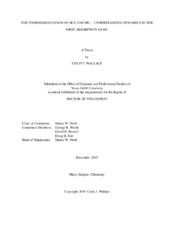| dc.description.abstract | This dissertation is focused on describing the photodissociation dynamics of both OCS and HN3 in the first UV absorption band. The photodissociation of OCS in the first UV absorption band has continuously been a test case for theoretical models. Experimental measurements using Velocity Map Ion Imaging (VELMI) at 214 nm uncovered previously unseen vibrational excitation of the CO fragment. The photodissociation of OCS is known to result in a j-dependent β parameter. The origin of the j-dependence has been hypothesized to occur via two different mechanisms: a two electronic state model and a non-axial recoil model. This work has confirmed the origin of the j-dependent β originates from two nearby electronic states, the A(21A^1) and B(1^1A”) electronic states, of OCS with opposite symmetry. Using these measurements in addition to experimental data from the literature the fractional contributions of each state excited state is determined. The contribution of the B state (fvB) did not agree well with theory over the first absorption band. Additionally, experimental measurements at 214 nm have indicated an underestimation in the surface hopping trajectories in the photodissociation of OCS, possibly originating from discrepancies in the calculated initial impulse along the bending coordinate or the coupling between the ground X(1^1A′ ) and A(2^1A ′ ). The photodissociation of HN3 in the first UV absorption band near 256 nm, 271 nm, and 285 nm were measured using VELMI. A series of images across the HN rotational distribution were collected at each wavelength. The experimental measurements at 285 nm are in good agreement with previous measurements in the literature. Speed dependent vector correlations were successfully measured using the recently developed 2+1 REMPI equations. The speed dependent vector correlations measured from the HN fragment provided insight into the correlated dynamics of the Nv2 cofragment.
The speed dependent vector correlations at 285 nm indicated the low jvN2 originated primarily from the νv5 in plane bend, with increasing dependence on the νv6 torsion with increasing jvN2 . In the future, additional measurements of the Nv2 fragment using a 2+2 REMPI scheme at 283 nm are possible. Ion images of the Nv2 fragment would allow for the direct determination of the Nv2 vector properties providing a way to validate the speed dependent vector correlations measured using the 2+1 HN REMPI scheme at 285 nm. Additional measurements at 256 nm and 271 nm are necessary to determine the accuracy of the vector correlations in the current data.
Keywords: Photodissociation, VELMI, vector correlations. | en |


